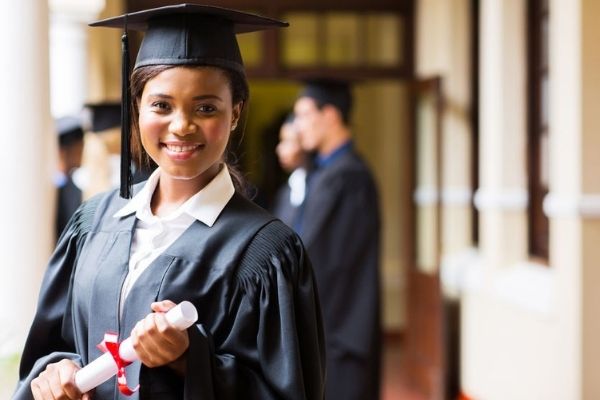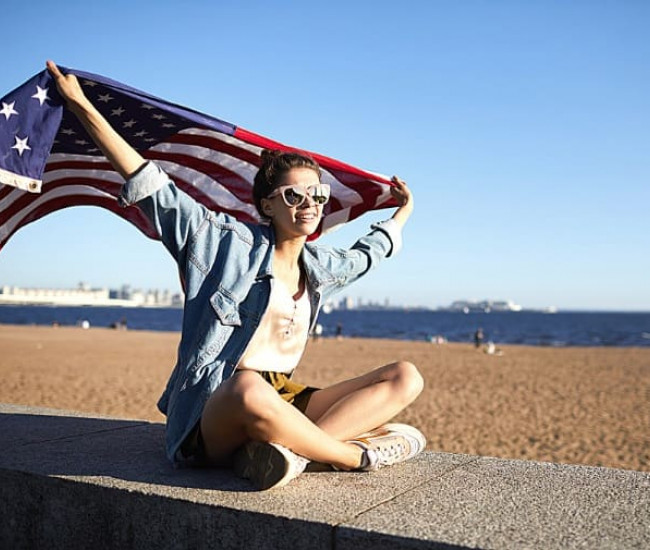 DE
DE
 EN
EN
- Entry to the USA
- Student visa
Student visa for the USA
Studying in the United States is a perfect career stepping stone. Therefore, the USA is one of the most popular study countries globally. Learn which visa categories are available for students in America and get important tips on how to apply.
- Studying in the USA: do I need a visa?
- Where can I study in the USA?
- Requirements for a US student visa
- F-1 Visa for students in the USA
- Terms and validity of an F-1 visa
- Costs for an F-1 visa
- J-1 Visa for exchange programs in the USA
- Duration and validity of a J-1 visa
- Cost of a J-1 Visa
- M-1 visa for a traineeship in the USA
- Duration and validity of an M-1 visa
- Costs for an M-1 visa
- What is the SEVIS fee?
- Applying for a student visa in the USA
- The application process for F-1 and M-1 student visas in the USA
- The application process for a J-1 visa in the USA
- What happens at the visa interview?
- Wait times for US student visas
- Visa approved: When can I travel to the USA?
- I finished my studies. How long can I stay in the USA?
- Convert a B-visa into a student visa
- Convert student visa to Green Card
- Can my family come to the USA with me?
- Visa application denied! What now?
Take the chance of living in the USA and apply for the official US Green Card Lottery!
Studying in the USA: do I need a visa?
For studies in the United States leading to a university degree, you will need a student visa. Visas for students belong to the category of non-immigrant visas and are subject to certain conditions.
Furthermore, internships and comparable programs are also considered in the student visa categories:
| Category | Purpose |
|---|---|
| F | Privately organized studies (e.g., university, college, high school, language courses) |
| J | Exchange programs (e.g., school, internship, au pair, research) |
| M | Non-academic educational programs (other than language courses) |
American schools and universities must have a SEVP certificate in order for you to enroll as a foreign student. Thus, you can only get an F-1 or M-1 visa for certified schools. This does not apply to J-1 exchange programs.
Short leisure study programs of up to 18 hours per week that do not count toward your university degree can be completed visa-free with an ESTA or B-visa.

Studying at a US university opens many career doors.
Where can I study in the USA?
Suppose you are thinking about studying abroad in the USA. In that case, it is best to refer to the current educational institutions listed with the Department of Homeland Security. The DHS regularly provides an up-to-date PDF of certified schools and universities and an overview of the application process.
Requirements for a US student visa
If you do not have a Green Card, the most important requirement for studying in the USA is being able to reimburse publicly subsidized costs from universities or educational institutions.
To apply for an F-1, J-1, or M-1 visa, you must also present the following proof or documents:
- A valid passport
- An official letter of admission
or a certificate of enrollment - A completed I-20 form (for F-1 and M-1 visas)
To be issued by the educational institution in the United States and mailed to you before your appointment at the US consulate. You must present the original I-20 form each time you enter the USA with your student visa. - A completed DS-2019 form (for J-1 visas)
To be issued by the exchange organization (called Sponsor on J-1 Visa) and sent to you prior to your appointment at the US consulate. You must present the original DS-2019 form each time you enter the United States with your student visa. - Sufficient funds
You must demonstrate that you are able to provide for the cost of living for your entire stay, in addition to the cost of your studies/program. - A tie to your home country
The US authorities want to make sure that you are not trying to illegally immigrate to the United States. Therefore, documents such as current leases, employment contracts, or proof of children in your home country are often required. - Sufficient language skills
For an F-1 or J-1 visa, you must prove your ability to speak English well enough by taking a standardized test. Common test providers include TOEFL (Test of English as a Foreign Language) or IELTS (International English Language Testing System). - Individual requirements of the study institution
Before applying for your visa, make sure that you meet all applicable entry requirements for your intended studies in the United States.
Saving tip
If you want to avoid high tuition fees in the USA, participate in the Green Card Lottery. Having a Green Card exempts you from the extra high fees foreigners pay for studying in the USA.
F-1 Visa for students in the USA
Most study programs offered by colleges, universities, conservatories, high schools, or language schools in the United States require you to apply for an F-1 visa.
In the case of language courses, this also depends on the intensity of the study: if a course is over 18 hours per week, an F-1 visa is required. With an F-1 visa, you may:
- study at a university
- attend a high school
- attend a private elementary school
- take an intensive language course
In exceptional cases, you may apply for a work permit to earn money during your studies in the USA.
Terms and validity of an F-1 visa
F-1 visas are usually issued for five years. However, your residence permit is firmly linked to the duration of your studies or language course, which is noted in the I-20 form. If your studies end, so does your residence permit.
If delays such as illness or a change of subject mean that you will not be able to complete your studies in the specified period, you may be eligible to apply for an extension of your F-1 visa.
Costs for an F-1 visa
The cost of an F-1 visa to study in the USA consists of consular fees and the so-called SEVIS fee.
| F-1 visa fee | Amount |
|---|---|
| Nonimmigrant visa processing fee | $ 185 |
| SEVIS fee | $ 350 |
J-1 Visa for exchange programs in the USA
The J-1 category covers exchange programs administered by the U.S. Department of State. The purpose of the J-1 visa is to promote educational and cultural exchanges between the United States and other nations. There is no requirement to be a student to apply for a J-1 visa. Instead, with a J-1 visa, you may:
- Complete an internship
- Work as an au pair
- Attend high school
- Work as a trainee
- Work in a summer job
Duration and validity of a J-1 visa
Depending on the program, the J-1 visa is valid for an average of between 12 and 24 months. Your residence permit is linked to the duration of your internship, employment, or exchange.
If delays mean that you will not be able to complete your internship, school year, or job in the specified time period, you may apply for an extension of your J-1 visa.
Cost of a J-1 Visa
The cost of a J-1 visa for internships, au pair jobs, high school years, summer jobs, or traineeships includes consular fees and the SEVIS fee, which varies in amount depending on the purpose:
| J-1 visa fee | Amount |
|---|---|
| Nonimmigrant visa processing fee | $ 185 |
| SEVIS fee for au pair and summer jobs | $ 35 |
| SEVIS fee for all other J-1 types | $ 220 |
M-1 visa for a traineeship in the USA
The M-1 visa allows you to receive education or training at a non-academic educational institution or facility such as a flight school, cosmetology school, or culinary school.
With an M-1 visa, you may:
- Go to a vocational school
- Attend trade courses
- Take other courses classified as vocational that are not academic
Language schools are excluded from the M-1 category (you would need an F-1 visa for this).

Professional training is covered by US student visa categories.
Duration and validity of an M-1 visa
The M-1 visa is valid for a maximum of 12 months or until the end of your education or training.
Suppose delays beyond your control prevent you from completing your education or training in the United States within the specified time. In that case, you may be eligible to apply for an extension of your M-1 visa.
Costs for an M-1 visa
The cost of an M-1 visa to train in the USA includes consular fees and the SEVIS fee.
| M-1 visa fees | Amount |
|---|---|
| Non-immigrant visa processing fee | $ 185 |
| SEVIS fee | $ 350 |
What is the SEVIS fee?
SEVIS stands for "Student and Exchange Visitor Information System" and refers to a database that allows the US government to keep track of all student visas issued.
Before you can apply for a student visa, you must pay this fee - otherwise, you will not get a visa.
Applying for a student visa in the USA
Depending on whether you choose a US government-sponsored exchange program (J-1) or privately organized studies (F-1 or M-1), the application process will slightly differ:
The application process for F-1 and M-1 student visas in the USA
- apply to a SEVP-approved school or university
- after acceptance: register with SEVIS and pay the SEVIS fee
- wait for the I-20 form from the school or university
- apply for your student visa at a US embassy or consulate using the "Online Nonimmigrant Visa Application" (Form DS-160)
- pay the visa fee
- schedule and attend the visa interview
The application process for a J-1 visa in the USA
- apply for an appropriate exchange program from those provided by the US government at J1visa.state.gov
- upon acceptance: register for SEVIS and pay the SEVIS fee
- apply for the J-1 visa at the U.S. Department of State using form DS-160
- pay the visa fee
- schedule and attend the visa interview
What happens at the visa interview?
In the visa interview at your local US embassy or consulate, you must confirm and prove the information you provided in the "Online Nonimmigrant Visa Application" (Form DS-160).
Therefore, you will need to present all original documents you received during the visa process or essential to prove the information you provided. These include:
- the I-20 form (for F-1 and M-1 visas)
- the DS-2019 form (for J-1 visas)
- the printed confirmation page of your DS-160 form
- your valid passport
- a passport photo
- the confirmation of the visa fee payment
- the appointment confirmation of the US consulate or embassy
- case-specific documents (please check with the US embassy or consulate for individual requirements in your case.)
The embassy or consulate staff member will inform you whether your visa is approved at the end of your interview. Once approved, you can start making arrangements to move to the USA.

The path to studying or an internship in the USA always involves the DS-160 application form.
Wait times for US student visas
The wait times for visa interview appointments vary depending on your place of residence and visa category. Check up-to-date times at your local embassy or consulate on the U.S. Department of State's visa appointment wait times page.
A new student visa will be issued no more than 120 days before the start date of a degree program. If you are already in the middle of your studies and need to apply for a visa extension, you may do so at any time as long as you are properly listed as a United States student visa holder in SEVIS.
It is recommended that you submit your visa application as soon as you receive your I-20 or DS-2019 form, respectively, from your educational institution or sponsor.
Visa approved: When can I travel to the USA?
With a new student visa, you may enter the United States no earlier than 30 days before your studies begin. Remember to carry your original I-20 or DS-209 form in addition to the usual entry documents.
I finished my studies. How long can I stay in the USA?
If the purpose of your student visa (i.e., your studies, internship, advanced training, or summer job) ends, you must be out of the country within 60 days.
Convert a B-visa into a student visa
Under certain conditions, you can make a so-called "change of status" if the reason for your stay in the USA changes spontaneously. This allows you to change from a normal visitor to an officially recognized US student.
To change your residency status, you must:
- meet all the requirements for the visa category you are seeking (e.g., F-1 or M-1)
- have all required documentation
- apply for your change of status using the I-539 form
Before applying for a change of status, check with U.S. Citizenship and Immigration Services (USCIS) for the documentation required in your personal case.
Convert student visa to Green Card
Applying for a Green Card is possible as an F-1, M-1, or J-1 student visa holder under certain conditions. Potential "entry routes" to become a Permanent Resident (Green Card holder) are:
- A US employer applies for an employment-based Green Card on your behalf.
- You marry a US citizen (Green Card by marriage).
- You win the Green Card Lottery.
- You have the status of a refugee.
- You take on a leading job in the US military after two years at the university.
- One of your parents is a US citizen.
Of all the ways to go from studying abroad in the United States to becoming a legal resident with Permanent Residency and a work permit, entering the Green Card Lottery is the easiest. The odds of you becoming one of the 55,000 annual Green Card winners are excellent.
Can my family come to the USA with me?
If you are entering the United States on an F-1, M-1, or J-1 visa, your spouse and unmarried children under the age of 21 may join you using F-2, M-2, or J-2 and remain in the United States for the duration of your studies.
To make this possible, you must register your family members with SEVIS as well (SEVIS Dependent Form), complete the DS-160 form for each individual, and provide proof of your relationship.
Visa application denied! What now?
Incomplete documents, inadequate financial resources, or errors in forms can lead to the rejection of your United States student visa. Also, sometimes the personal impression of the consulate staff or a so-called "background check" plays a role.
If you know the reasons for your rejection, you can reapply (you are allowed to apply three times within one year).
However, if you are unsure of the exact reasons, seek advice from your local US consulate or the team of experts at The American Dream's US Visa Service.


